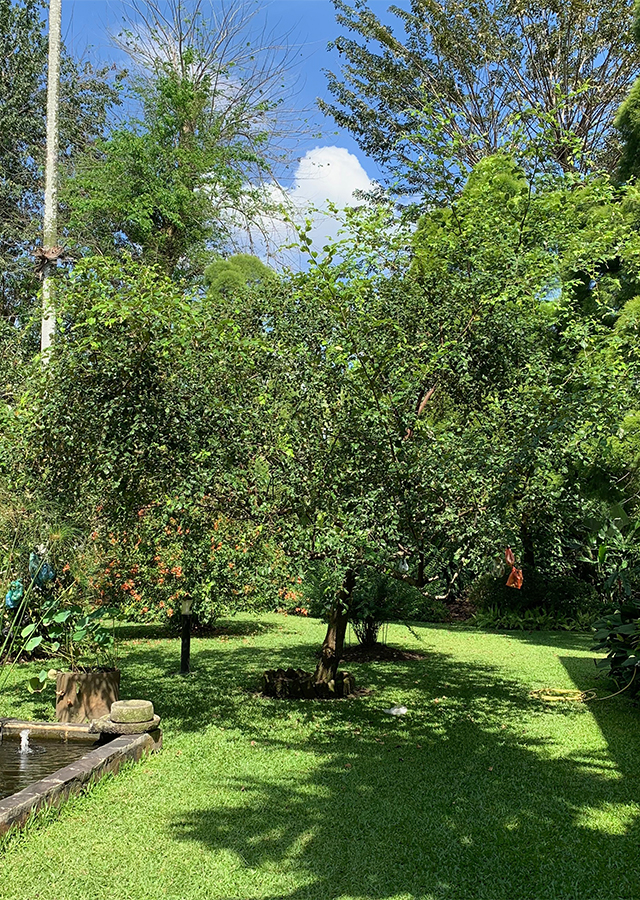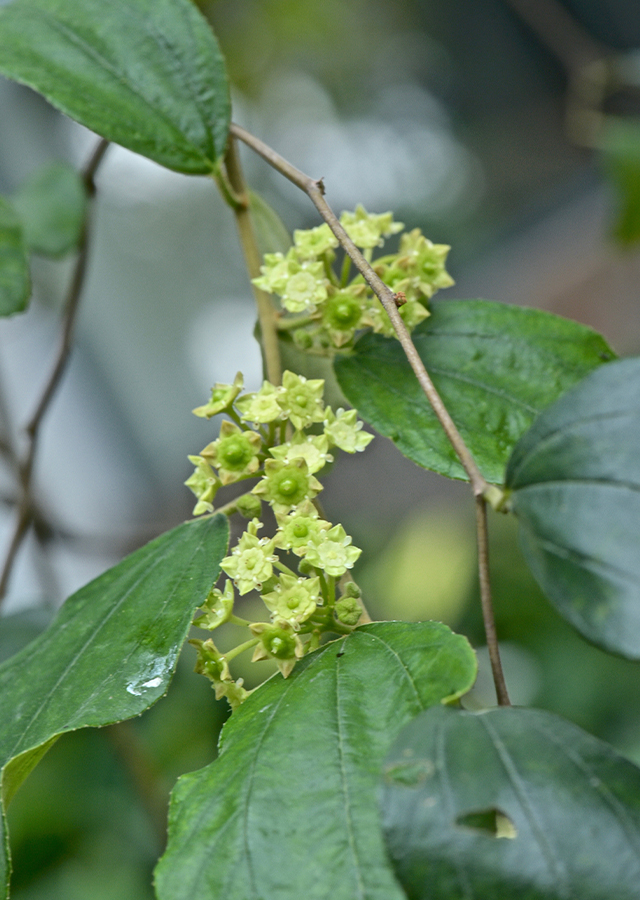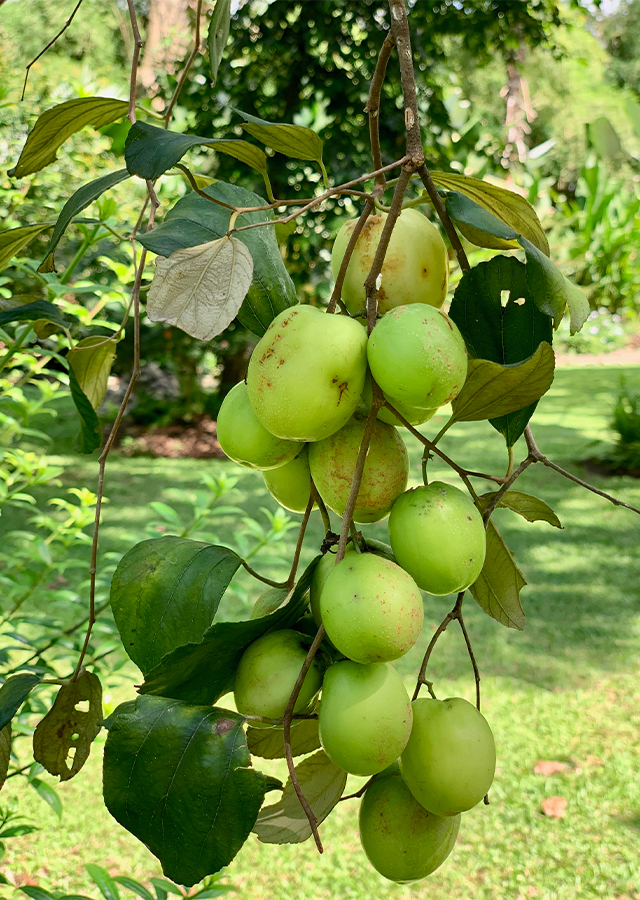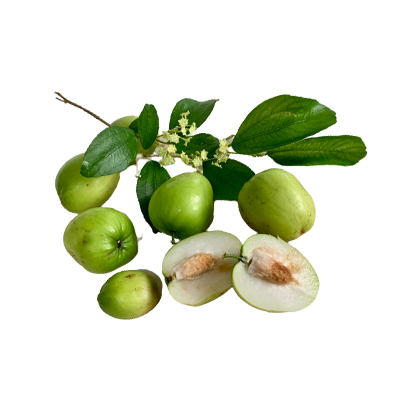Indian Jujube
Ziziphus mauritiana Lam.
Rhamnaceae
Location in our garden
Principal



Synonym
Paliurus mairei H.Lév.
Rhamnus jujuba L.
Sarcomphalus mauritianus (Lam.) Raf.
Habitus
Shrubs. A spiny, almost evergreen, perennial shrub or small tree, 3 to 15 m in height
Part Used
Leaves
Bark
Fruit
Roots
Growing Requirements
Full Sunshine
Drought Resistant
Habitat
Riverbanks
Forest
Coastal
Shrublands
Overview
Indian jujube is a valuable commercial fruit crop in its native Asia, mostly in India and China, the plant also widely cultivated in various other regions including Africa, Australia, the Pacific and the Americas.
Vernacular Names
Dian ci zao (Chinese), Jujubier (French), Filzblättrige jujube (German), Bogori (India), Indo natsume (Japanese), Epal siam (Malaysia), and Bidara (Indonesia).
Agroecology
It is found growing in combination with other drought-adapted woody and herbaceous species. It tolerates a wide range of temperatures from -5 °C to 49 °C and requires little rainfall. Deep sandy to loamy soils are considered best for optimum growth. It grows in well-drained sandy loams, shingle alluvium, sand dunes, skeletal and gravelly soils, laterite and black cotton soils and prefers soils with a pH of around 7.5. It also occurs in undulating ravines and gentle slopes from 0 to 1,500 m, sometimes reaching 1,800 m altitude.
Morphology
- Roots - deep and lateral.
- Barks - dark grey, dull black or reddish with long vertical fissures, reddish and fibrous inside. The branches are spreading, droop at the ends, the twigs are softly tomentose when young.
- Leaves - simple, shining green above and whitish tomentose beneath, due to persistent dense hairs, margins minutely serrulate, three basal nerves and two stipular spines, one long and straight, the other small and curved back, and often brown in colour.
- Flowers - minute, greenish-white or yellow, hermaphrodite, in sessile or shortly peduncled axillary cymes, and are insect pollinated with an acrid smell.
- Fruits - initially green and turns yellow, orange, and red on ripening; being a drupe containing sour-sweet pulp and a hard stone. It varies in size from 1.2-3.7 cm long, and is generally globose or ovoid, and glossy.
- Seeds - a tuberculate and irregularly furrowed stone, containing 1–2 elliptic red-brown kernels each 6 mm long.
Cultivation
Propagated by seeds and root suckers.
Chemical Constituents
Flavonoids, alkaloids, glycoside, saponin, polyphenol, tannins, triterpenoid, jujubosides, betulinic acid, ceanothic acid, frangufoline, spinosin, daucosterol, docosanoic acid, stearic acid, and palmitoleic acid.
Traditional Medicinal Uses
Medicinal Uses
- The plant have various pharmacological activities such as antioxidant, hepatoprotective, antidiarrhoeal, anti microbial, antihyperglycemic/ hypoglycemic and antiplasmodial activities.
- Leaves are astringent, used for liver troubles, asthma, fever and wounds.
Traditional Uses
- Fruits are used to purify the blood, aid in weak digestion, indigestion, biliousness, pulmonary ailments, and fevers.
- Seeds are sedative used to halt nausea, vomiting, abdominal pains in pregnancy, diarrhea, poulticed on wounds, and rubbed on rheumatic areas.
- Decoction of the bark and leaves is used for dysentery, diarrhea, bowel ailments, also to relieve gingivitis. As paste for sores. As tonic for indigestion. As poultice for stomach-ache.
- Root is purgative, decoction is used for febrifuge, taenicide, and emmenagogue. Powdered root is dusted on wounds. Juice of the root bark is said to alleviate gout and rheumatism.
- An infusion of the flowers serves as an eye lotion.
Part Used
Reference Sources
- CABI. (2007). Invasive Species Compendium. Ziziphus mauritiana (Jujube). https://www.cabi.org/isc/datasheet/57556. 11-02-2021.
- Fern, K. (2014). Useful Tropical Plants: Ziziphus mauritiana. http://tropical.theferns.info/viewtropical.php?id=Ziziphus+mauritiana. 11-02-2021.
- HealthBenefitsTimes.com. (No date). Health benefits of Indian jujube. https://www.healthbenefitstimes.com/indian-jujube/. 11-02-2021.
- Lim, T. K. (2013). Edible Medicinal and Non-Medicinal Plants: Vol. 5, Fruits. Springer. DOI 10.1007/978-94-007-5653-3_2. (pp.605-613).
- StuartXchange. (2016). Philippines Medicinal Plants. Ziziphus mauritiana Lam. http://www.stuartxchange.com/Mansanitas.html. 11-02-2021.



